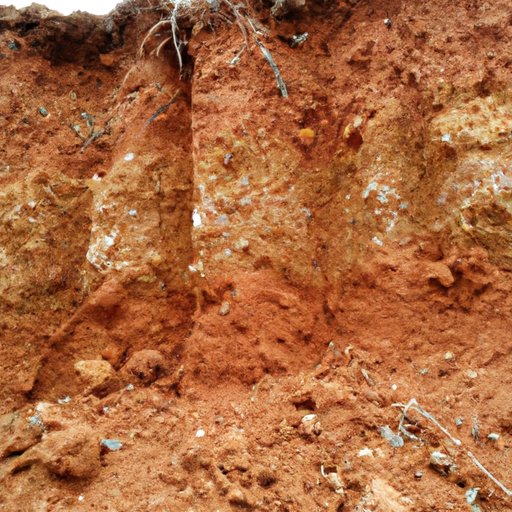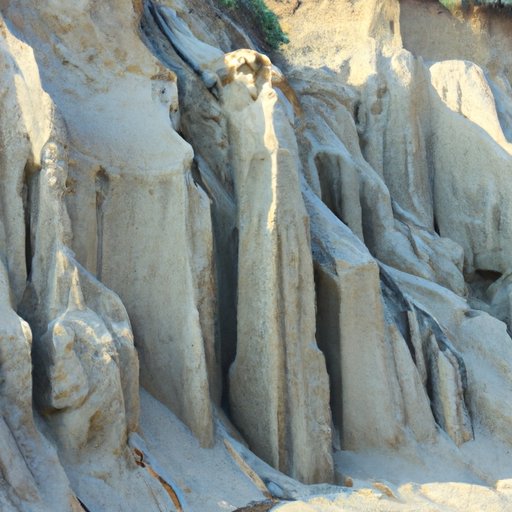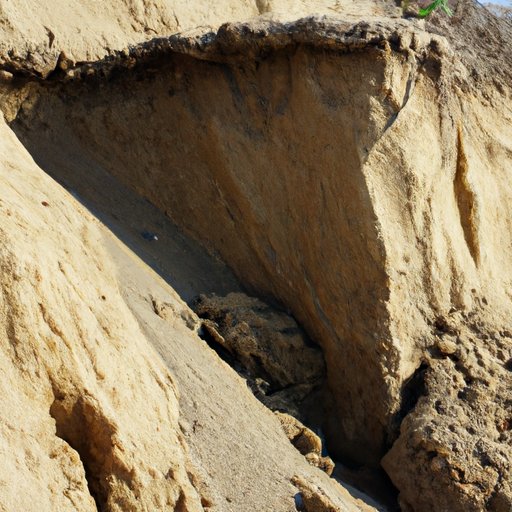Introduction
Erosion is a natural process that occurs when wind, water, ice, or other forces wear away at the Earth’s surface. It can be caused by a variety of factors, such as weathering, wind, water, and the movement of glaciers and ice sheets. These forces work together to shape the Earth’s landforms, creating valleys, mountains, and other features. Erosion is an important part of the planet’s natural cycle, as it helps create new habitats for plants and animals, as well as providing nutrients for soil.
The different types of erosion include wind erosion, water erosion, glacier and ice erosion, and chemical erosion. Each type of erosion has its own unique characteristics, and can cause different levels of damage to the environment. In this article, we will explore the science of erosion and discuss its causes, effects, and potential solutions.
Exploring the Science of Erosion: Causes, Effects, and Solutions
Erosion can have significant impacts on the environment, and is a key factor in the formation of natural landscapes. To understand the science behind erosion, it is important to examine its causes, effects, and potential solutions.
Investigating the Causes of Erosion
The primary causes of erosion are weathering, wind, water, and the movement of glaciers and ice sheets. Weathering is the gradual breakdown of rock and soil due to the action of wind, water, and temperature changes. Wind erosion is the process of particles being blown away by the wind, while water erosion occurs when running water carries away sediment and rocks. Glaciers and ice sheets move slowly across the landscape, carrying with them large amounts of sediment.
Examining the Effects of Erosion
The effects of erosion can be both positive and negative. On the one hand, erosion can help create new habitats for plants and animals, as well as providing nutrients for soil. On the other hand, it can also lead to soil degradation and loss of vegetation cover, which can reduce the productivity of agricultural land. Erosion can also increase runoff, leading to flooding and siltation of rivers and streams. In extreme cases, it can even lead to landslides and mudslides.
Analyzing Potential Solutions to Erosion
There are several potential solutions to the problem of erosion. One way to reduce erosion is through the use of terraces, which are small raised areas of land designed to slow down the flow of water. Planting vegetation can also help reduce erosion by providing ground cover, which helps to stabilize the soil. Other methods of controlling erosion include the construction of dams and levees, as well as the use of gabions and rock barriers.

A Comprehensive Guide to Understanding Erosion in Science
In order to gain a better understanding of erosion in science, it is important to examine the dynamics of erosion over time, as well as the interplay between erosion and climate change. Additionally, it is important to analyze the impact of human activity on erosion.
Uncovering the Dynamics of Erosion Through Time
Erosion is a dynamic process that has been occurring since the formation of the Earth. According to a study conducted by the University of California Santa Barbara, “the long-term history of erosion is marked by episodes of rapid erosion during mountain building and periods of relative stability during which erosion rates remain low.” This means that erosion rates can vary significantly over time, depending on the type of terrain and the forces of nature that are at play.
Examining the Interplay Between Erosion and Climate Change
Climate change is having a major impact on the rate of erosion. As the climate warms, glaciers and ice sheets melt, resulting in increased runoff and higher levels of erosion. Additionally, increases in precipitation can lead to more intense storms, which can cause greater amounts of soil to be washed away. The effects of climate change on erosion are especially pronounced in areas where there is already a high level of human activity, such as in urban areas.
Analyzing the Impact of Human Activity on Erosion
Human activity can also have a significant impact on erosion. The construction of roads, buildings, and other infrastructure can disrupt natural drainage patterns and lead to increased levels of erosion. Additionally, deforestation and overgrazing can lead to soil degradation and an increased rate of erosion. In order to reduce the impact of human activity on erosion, it is important to practice sustainable land management practices, such as replanting trees and using cover crops to protect the soil.

An Overview of Different Types of Erosion
As mentioned earlier, there are four main types of erosion: wind, water, glaciers and ice, and chemical. Each type of erosion has its own unique characteristics, and can cause different levels of damage to the environment.
Wind Erosion
Wind erosion occurs when particles are blown away by the wind. It can result in the creation of sand dunes, as well as the formation of gullies and rills. Wind erosion is most common in arid and semi-arid regions, and can be particularly damaging to agricultural land.
Water Erosion
Water erosion occurs when running water carries away sediment and rocks. It is a major cause of soil degradation, and can contribute to the formation of gullies, ravines, and other features. Water erosion is particularly problematic in areas prone to flooding or heavy rainfall.
Glaciers and Ice Erosion
Glaciers and ice sheets move slowly across the landscape, carrying with them large amounts of sediment. This sediment is then deposited in valleys and other areas, helping to form the distinctive features of glacial landscapes. Glaciers and ice erosion can also lead to the formation of moraines, which are ridges of sediment left behind by retreating glaciers.
Chemical Erosion
Chemical erosion occurs when acid rain reacts with rocks and soils, causing them to break down. It can also occur when pollutants, such as fertilizers and pesticides, are carried into rivers and streams. Chemical erosion can have a significant impact on the environment, as it can lead to water contamination and soil degradation.

Investigating the Role of Erosion in Natural Landscapes
Erosion plays an important role in shaping natural landscapes. By examining the relationship between erosion and other natural processes, such as mountain building and soil formation, we can gain a better understanding of how erosion affects the environment.
Examining the Role of Erosion in Mountain Building
Erosion is an important factor in the formation of mountains. Over time, wind, water, and glaciers erode away at the land, creating valleys and other features. This erosion helps to expose underlying rocks, which can then be uplifted by tectonic forces, forming mountains.
Exploring the Interaction Between Erosion and Soil Formation
Erosion is also an important factor in the formation of soil. When rocks and minerals are eroded away, they become part of the soil, providing essential nutrients for plants. Erosion can also help to create new soil by exposing fresh layers of material that can be colonized by microorganisms.
Analyzing the Relationship Between Erosion and Plant Life
Erosion can also have an impact on plant life. According to a study published in the journal Nature, “erosion can affect the availability of resources for plants, such as water and nutrients, as well as the physical structure of the soil.” Erosion can also alter the landscape, making it more suitable for certain species of plants.
Conclusion
In conclusion, erosion is a natural process that has a significant impact on the environment. It can be caused by a variety of factors, such as weathering, wind, water, and the movement of glaciers and ice sheets. Erosion can have both positive and negative effects, and can lead to soil degradation and loss of vegetation. There are several potential solutions to the problem of erosion, such as terraces, planting vegetation, and the construction of dams and levees. Finally, it is important to understand the dynamics of erosion over time, as well as the interplay between erosion and climate change.
Erosion is a complex phenomenon that plays an important role in shaping the environment. By understanding the science behind erosion, we can gain a better appreciation for its importance in the natural world.
Summary of the Main Points
This article explored the science of erosion, including its causes, effects, and potential solutions. It examined the dynamics of erosion over time, as well as the interplay between erosion and climate change. Additionally, it analyzed the impact of human activity on erosion, and provided an overview of different types of erosion. Finally, it discussed the role of erosion in natural landscapes, such as mountain building and soil formation.
Final Considerations
Erosion is a natural process that has a profound effect on the environment. By understanding the science behind erosion, we can gain a better appreciation for its importance in the natural world. Additionally, it is important to be aware of the potential impacts of human activity on erosion, and to take steps to reduce its negative effects.
(Note: Is this article not meeting your expectations? Do you have knowledge or insights to share? Unlock new opportunities and expand your reach by joining our authors team. Click Registration to join us and share your expertise with our readers.)
